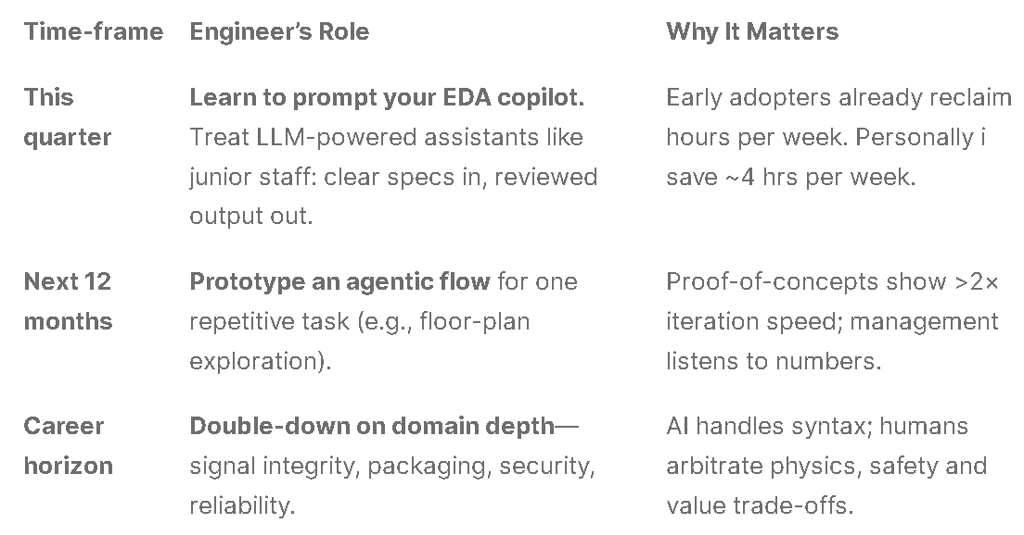EDA Scripts to Agentic Workflows: Why Engineers Still Sit at the Center of AI-Driven Chip Design
Memory Matters #48


Its been a while since i last posted as i have taken a needed summer break from blogging. This latest read has reinvigorated my interest. Four days ago Ed Sperling’s round-table “How AI Will Impact Chip Design and Designers” united voices from Cadence, Synopsys, Siemens EDA and several AI-first startups. The consensus? AI is no longer a feature—it’s the fabric of next-generation silicon development [1]. Lets take a coffee break and review some of the informational pass downs from this leading discussion.
1. AI’s Reach: Horizontal and Vertical
“AI is going to be pervasive… a horizontal that’s going to impact every vertical, from spec to tape-out and beyond.”
-- Anand Thiruvengadam, Synopsys
That single line reframes our job descriptions. Whether you’re architecting neural-network tiles, crafting RTL, or closing timing, AI agents are beginning to co-own your flow. The tools we wrote in base scripting languages are morphing into co-generative sidekicks that learn our constraints and refactor them in minutes, not days. This allows senior engineers and architect to work on what matters relating to Compute, Memory and the Interconnect.
2. The Near-Term Payoff Is Productivity
Cadence fellow Chuck Alpert refers to today’s wave as “help-assistance and co-generation.” This approach automates constraint files and debug sessions, allowing junior talent to ramp up more quickly while enabling seniors to focus on strategic tasks.
This evolution not only enhances efficiency but also fosters a collaborative environment where creativity can thrive. As AI tools take on more routine tasks, engineers can dedicate their time to innovative design solutions and complex problem-solving. The shift towards this integrated approach signals a transformative era in chip design, where human intuition and AI capabilities work hand in hand.
3. The Next Wave Is Agentic
The panel draws a hard line between incremental automation and agentic workflows—autonomous toolchains that search, synthesize, and optimize with minimal human checkpoints. These advanced systems not only streamline the design process but also adapt to evolving project requirements in real-time. When an SoC must tape-out every 12 months, agentic AI isn’t optional; it’s the only way to compress the schedule without burning out the team while delivering the Tier1 SoC of Choice.
4. Talent Shortage, Not Job Shortage
Worried AI will delete engineering roles? The experts disagree. Productivity gains amplify demand, they don’t shrink it—and every shortcut creates fresh corners to innovate. The real gap is domain expertise: customers “don’t want a tool expert, they want a problem expert.” As the industry evolves, engineers will find themselves in roles that require not just technical skills, but also the ability to interpret complex data and provide strategic insights. This shift emphasizes the importance of continuous learning and adaptability in a rapidly changing landscape. Ultimately, the integration of AI will empower engineers to focus on high-value tasks that drive innovation and growth.
Your Action Plan
Closure Report
Thank you https://semiengineering.com/ for aligning to this very important conversation.
While Nickelback famously exclaimed that "We all Want to Be Rock Stars" - the focused truly work to make this a reality. This panel, sponsored by SemiEngineering, outlines the focus many need in a scattered AI world. The article’s panelists agree on one thing: engineers who pair deep domain insight with AI fluency will steer the next decade of silicon—whether inside a Hyperscaler or at a three-person startup. So crack open that reinforcement-learning paper, refactor an old script with an LLM, and start architecting workflows that free you for the hard questions only humans can ask and currently answer. The future of AI compute isn’t just faster GPUs or exotic XPUs. It’s you, the engineer, wielding intelligent tools to bend transistors—and timelines—to your will.
As our friend Jocko Willink commonly reminds us - Go Get It!
References
[1] https://semiengineering.com/how-ai-will-impact-chip-design-and-designers/


